Modified Uni-Traveling-Carrier Photodetector with Its Optimized Cliff Layer
Abstract
1. Introduction
2. Device Structure Design and Simulation Analysis
2.1. Simulation Method
2.2. Epitaxy Structure Design
2.3. Theoretical Analysis and Characteristics Comparison
2.4. Performance Comparison and Analysis
3. Conclusions
Author Contributions
Funding
Institutional Review Board Statement
Informed Consent Statement
Data Availability Statement
Conflicts of Interest
References
- Chen, Z.; Han, C.; Wu, Y.; Li, L.; Huang, C.; Zhang, Z.; Wang, G.; Tong, W. Terahertz wireless communications for 2030 and beyond: A cutting-edge frontier. IEEE Commun. Mag. 2021, 59, 66–72. [Google Scholar] [CrossRef]
- Wang, C.X.; Wang, J.; Hu, S.; Jiang, Z.H.; Tao, J.; Yan, F. Key technologies in 6G terahertz wireless communication systems: A survey. IEEE Veh. Technol. Mag. 2021, 16, 27–37. [Google Scholar] [CrossRef]
- Yi, C.; Kim, D.; Solanki, S.; Kwon, J.-H.; Kim, M.; Jeon, S.; Ko, Y.-C.; Lee, I. Design and performance analysis of THz wireless communication systems for chip-to-chip and personal area networks applications. IEEE J. Sel. Areas Commun. 2021, 39, 1785–1796. [Google Scholar] [CrossRef]
- Navaratna, N.; Tan, Y.J.; Kumar, A.; Gupta, M.; Singh, R. On-chip topological THz biosensors. Appl. Phys. Lett. 2023, 123, 033705. [Google Scholar] [CrossRef]
- Ahmadivand, A.; Gerislioglu, B.; Ahuja, R.; Mishra, Y.K. Terahertz plasmonics: The rise of toroidal metadevices towards immunobiosensings. Mater. Today 2020, 32, 108–130. [Google Scholar] [CrossRef]
- Yang, K.; Li, J.; de la Chapelle, M.L.; Huang, G.; Wang, Y.; Zhang, J.; Xu, D.; Yao, J.; Yang, X.; Fu, W. A terahertz metamaterial biosensor for sensitive detection of microRNAs based on gold-nanoparticles and strand displacement amplification. Biosens. Bioelectron. 2021, 175, 112874. [Google Scholar] [CrossRef]
- Huang, Y.; Shen, Y.; Wang, J. From terahertz imaging to terahertz wireless communications. Engineering 2023, 22, 106–124. [Google Scholar] [CrossRef]
- Stantchev, R.I.; Yu, X.; Blu, T.; Pickwell-MacPherson, E. Real-time terahertz imaging with a single-pixel detector. Nat. Commun. 2020, 11, 2535. [Google Scholar] [CrossRef] [PubMed]
- Hirata, A.; Harada, M.; Nagatsuma, T. 120-GHz wireless link using photonic techniques for generation, modulation, and emission of millimeter-wave signals. J. Light. Technol. 2003, 21, 2145–2153. [Google Scholar] [CrossRef]
- Ito, H.; Furuta, T.; Nakajima, F.; Yoshino, K.; Ishibashi, T. Photonic generation of continuous THz wave using uni-traveling-carrier photodiode. J. Light. Technol. 2005, 23, 4016–4021. [Google Scholar] [CrossRef]
- Wun, J.-M.; Liu, H.-Y.; Zeng, Y.-L.; Yang, S.-D.; Pan, C.-L.; Huang, C.-B.; Shi, J.-W. Photonic High-Power Continuous Wave THz-Wave Generation by Using Flip-Chip Packaged Uni-Traveling Carrier Photodiodes and a Femtosecond Optical Pulse Generator. J. Light. Technol. 2016, 34, 1387–1397. [Google Scholar] [CrossRef]
- Jia, S.; Lo, M.C.; Zhang, L.; Ozolins, O.; Udalcovs, A.; Kong, D.; Pang, X.; Guzman, R.; Yu, X.; Xiao, S.; et al. Integrated dual-laser photonic chip for high-purity carrier generation enabling ultrafast terahertz wireless communications. Nat. Commun. 2022, 13, 1388. [Google Scholar] [CrossRef]
- Nagatsuma, T.; Ducournau, G.; Renaud, C. Advances in terahertz communications accelerated by photonics. Nat. Photon 2016, 10, 371–379. [Google Scholar] [CrossRef]
- Koenig, S.; Lopez-Diaz, D.; Antes, J.; Boes, F.; Henneberger, R.; Leuther, A.; Tessmann, A.; Schmogrow, R.; Hillerkuss, D.; Palmer, R.; et al. Wireless sub-THz communication system with high data rate. Nat. Photon. 2013, 7, 977–981. [Google Scholar] [CrossRef]
- Ishibashi, T.; Fushimi, H.; Ito, H.; Furuta, T. High power uni-traveling-carrier photodiodes. In Proceedings of the International Topical Meeting on Microwave Photonics. MWP’99. Technical Digest (Cat. No. 99EX301), Melbourne, VIC, Australia, 17–19 November 1999; IEEE: Piscataway, NJ, USA, 1999; pp. 75–78. [Google Scholar]
- Zhang, J.; Zhang, J.; Wang, Q.; Chen, J.; Hua, B.; Cai, Y.; Lei, M.; Zhu, M. Experimental Comparison of Commercial PIN-PD and UTC-PD for THz Power and Transmission Performance in the 370 GHz–430 GHz. In Proceedings of the 2023 Opto-Electronics and Communications Conference (OECC), Shanghai, China, 2–6 July 2023; pp. 1–4. [Google Scholar]
- Nellen, S.; Ishibashi, T.; Deninger, A.; Kohlhaas, R.B.; Liebermeister, L.; Schell, M.; Globisch, B. Experimental Comparison of UTC- and PIN-Photodiodes for Continuous-Wave Terahertz Generation. J. Infrared Milli. Terahz. Waves 2020, 41, 343–354. [Google Scholar] [CrossRef]
- Chao, E.; Xiong, B.; Sun, C.; Hao, Z.; Wang, J.; Wang, L.; Han, Y.; Li, H.; Yu, J.; Luo, Y. D-band MUTC photodiodes with flat frequency response. IEEE J. Sel. Top. Quantum Electron. 2021, 28, 3802208. [Google Scholar] [CrossRef]
- Li, Z.; Pan, H.; Chen, H.; Beling, A.; Campbell, J.C. High-saturation-current modified uni-traveling-carrier photodiode with cliff layer. IEEE J. Quantum Electron. 2010, 46, 626–632. [Google Scholar] [CrossRef]
- Kirk, C.T. A theory of transistor cutoff frequency (f T) falloff at high current densities. IRE Trans. Electron. Devices 1962, 9, 164–174. [Google Scholar] [CrossRef]
- Li, N.; Li, X.; Demiguel, S.; Zheng, X.; Campbell, J.C.; Tulchinsky, D.A.; Sudharsansan, R. High-saturation-current charge-compensated InGaAs-InP uni-traveling-carrier photodiode. IEEE Photonics Technol. Lett. 2004, 16, 864–866. [Google Scholar] [CrossRef]
- Shi, J.W.; Wu, Y.S.; Wu, C.Y.; Chiu, P.-H.; Hong, C.-C. High-speed, high-responsivity, and high-power performance of near-ballistic uni-traveling-carrier photodiode at 1.55-μm wavelength. IEEE Photonics Technol. Lett. 2005, 17, 1929–1931. [Google Scholar] [CrossRef]
- Wu, Y.S.; Shi, J.W.; Chiu, P.H. Analytical modeling of a high-performance near-ballistic uni-traveling-carrier photodiode at a 1.55-μm wavelength. IEEE Photonics Technol. Lett. 2006, 18, 938–940. [Google Scholar] [CrossRef]
- Sharafi, F.; Orouji, A.A.; Soroosh, M. A novel field effect photodiode to control the output photocurrent and fast optical switching. Opt. Quantum Electron. 2022, 54, 171. [Google Scholar] [CrossRef]
- Li, J.; Xiong, B.; Luo, Y.; Sun, C.; Wang, J.; Hao, Z.; Li, H. Ultrafast dual-drifting layer uni-traveling carrier photodiode with high saturation current. Opt. Express 2016, 24, 8420–8428. [Google Scholar] [CrossRef] [PubMed]
- Li, Q.; Li, K.; Fu, Y.; Xie, X.; Yang, Z.; Beling, A.; Campbell, J.C. High-power flip-chip bonded photodiode with 110 GHz bandwidth. J. Light. Technol. 2016, 34, 2139–2144. [Google Scholar] [CrossRef]
- Guen-Bouazza, A.; Sayah, C.; Bouazza, B.; Chabane-Sari, N.E. Steady-state and transient electron transport within bulk InAs, InP and GaAs: An updated semiclassical three-valley monte carlo simulation analysis. J. Mod. Phys. 2013, 4, 616–621. [Google Scholar] [CrossRef]
- Cui, Y.; Qu, G. Design of Optical Fiber Communication System Under Carrier Photodiode/Compact PCI Bus and Signal Data Modulation. J. Nanoelectron. Optoelectron. 2022, 17, 495–504. [Google Scholar] [CrossRef]
- Li, J.; Xiong, B.; Luo, Y.; Sun, C.; Hao, Z.; Wang, J.; Han, Y.; Wang, L.; Li, H. High-power, wide-bandwidth modified uni-traveling-carrier photodiodes with an optimized depletion region. Appl. Phys. Express 2016, 9, 052203. [Google Scholar] [CrossRef]
- Friese, S. ATLAS. ti 8 Mac-User Manual Updated for Program Version 8.4; Atlas. Ti: Berlin, Germany, 2019. [Google Scholar]
- Dong, X.; Liu, K.; Huang, Y.; Duan, X.; Wang, Q.; Ren, X. Design of High-Speed UTC-PD with Optimization of Its Electron Transit Performance and Parasitic Capacitance. IEEE Photonics J. 2023, 15, 6800309. [Google Scholar] [CrossRef]
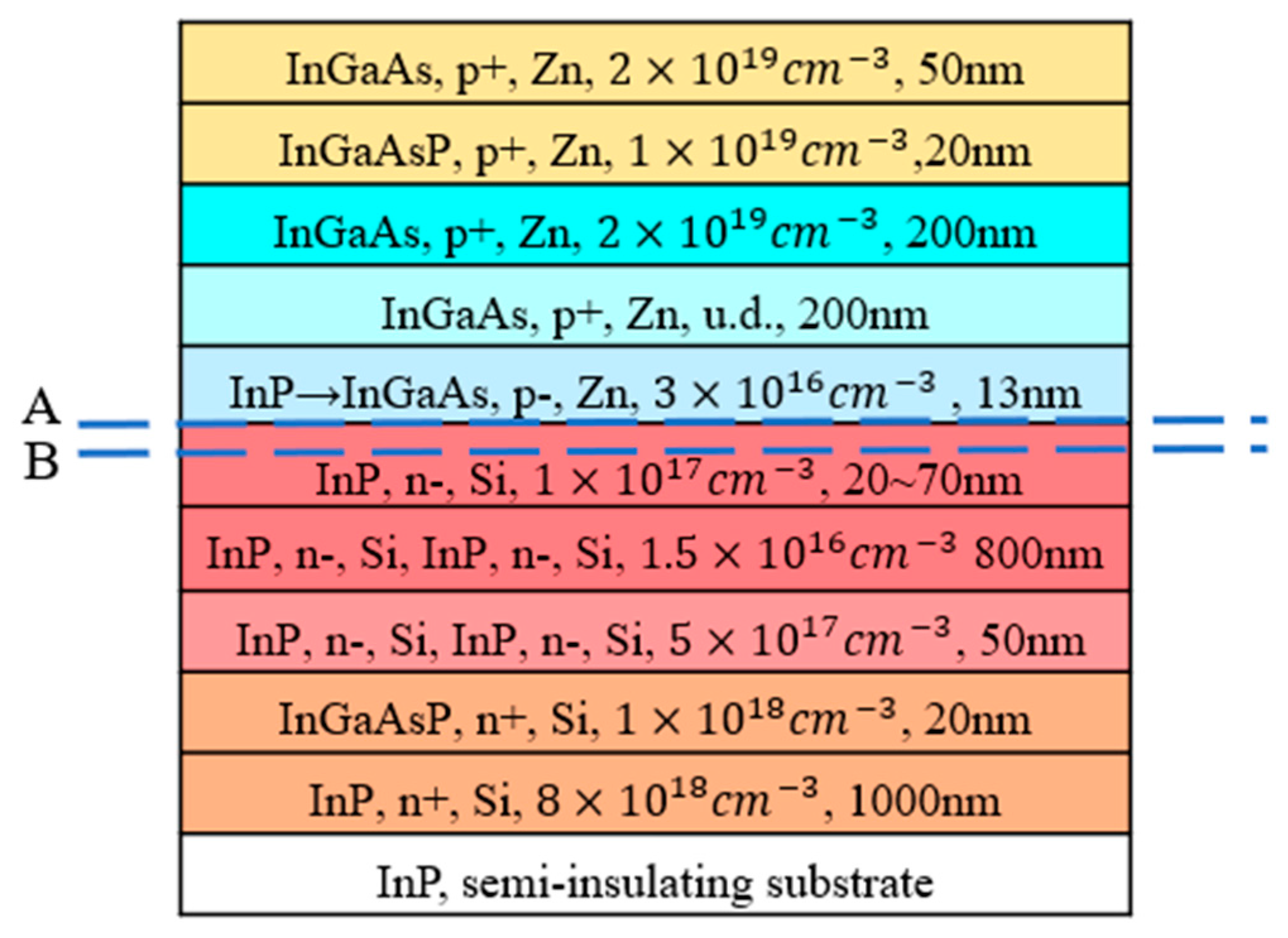
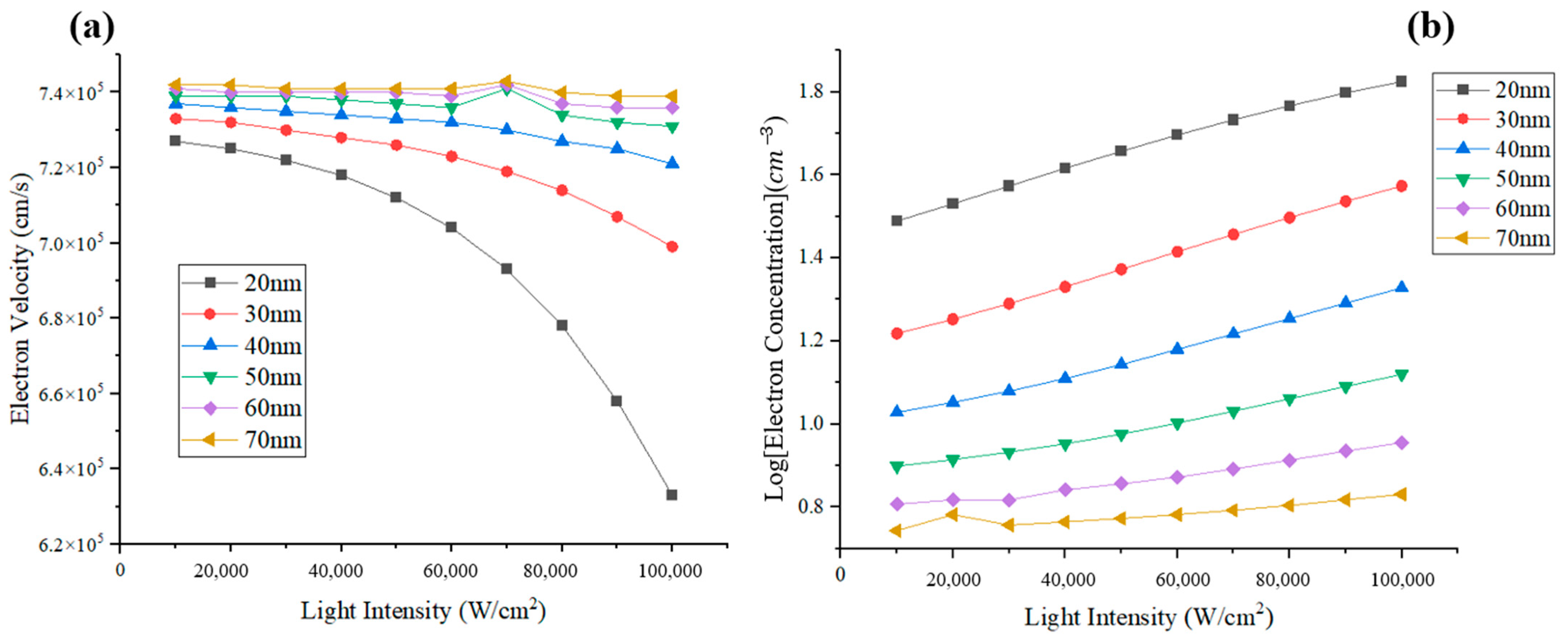



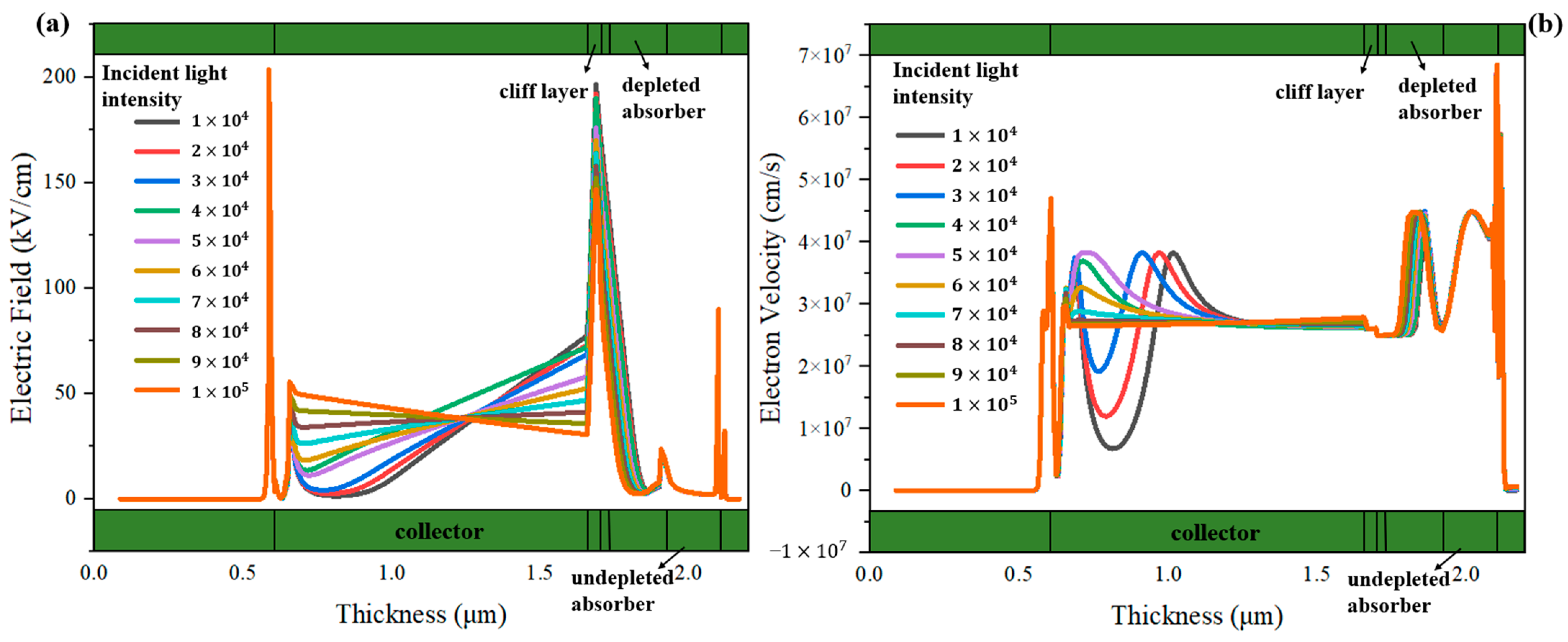
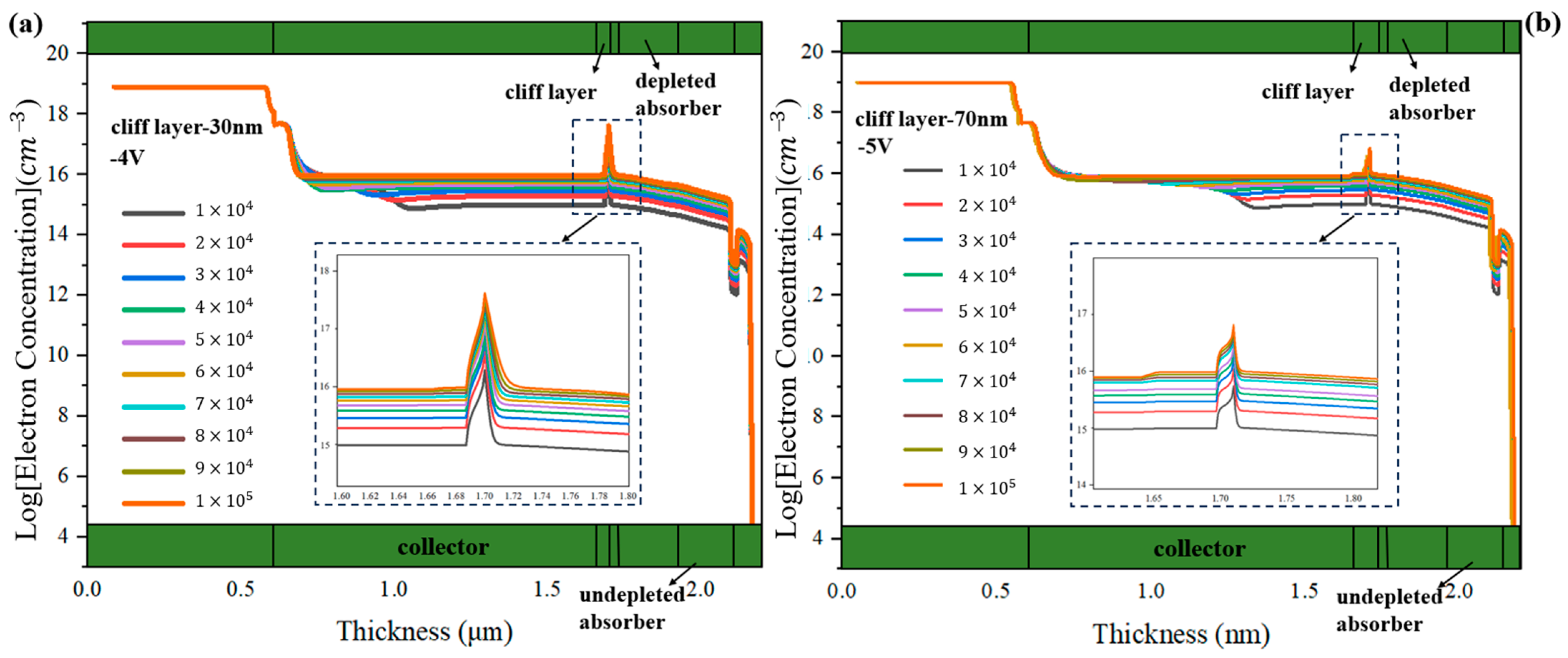
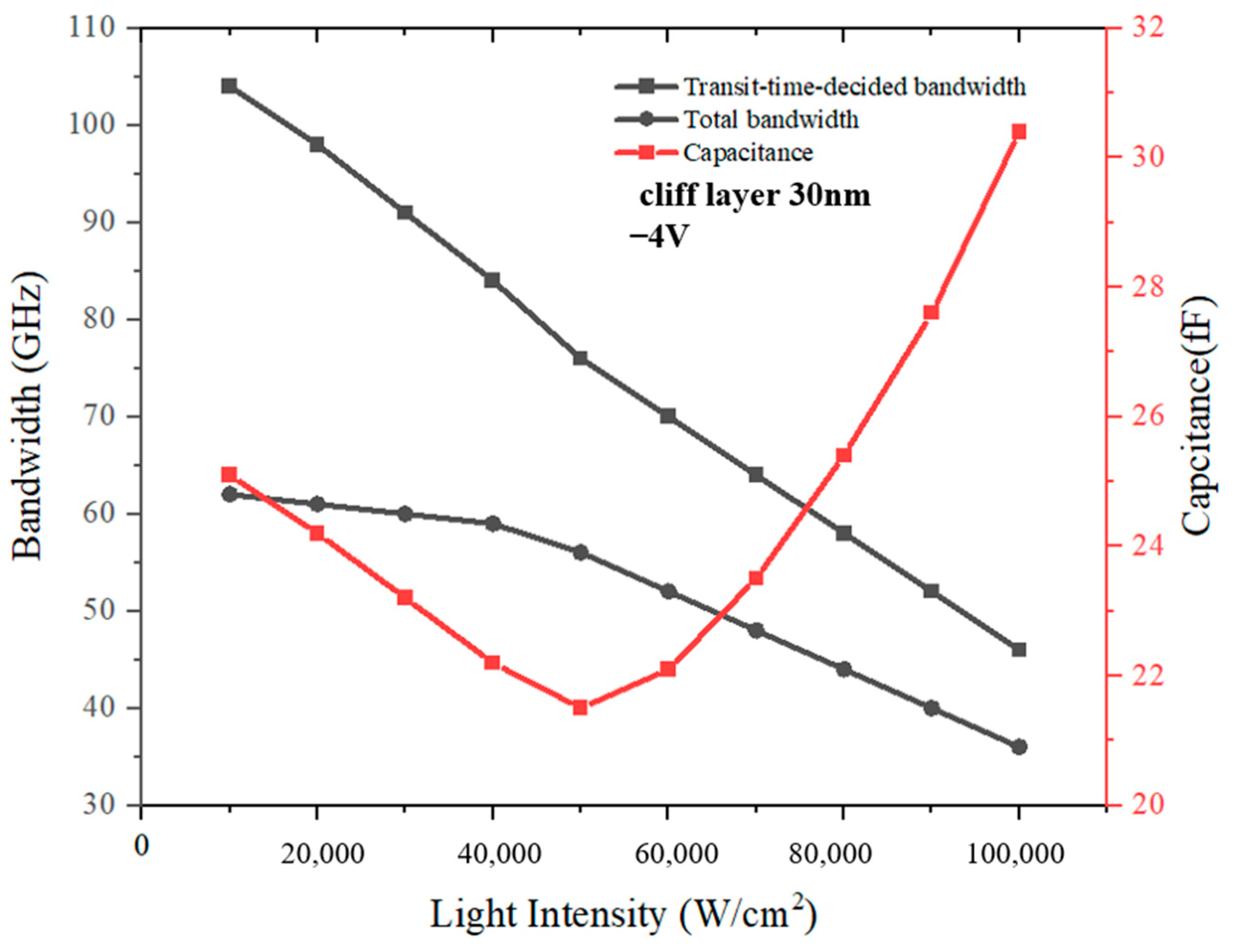
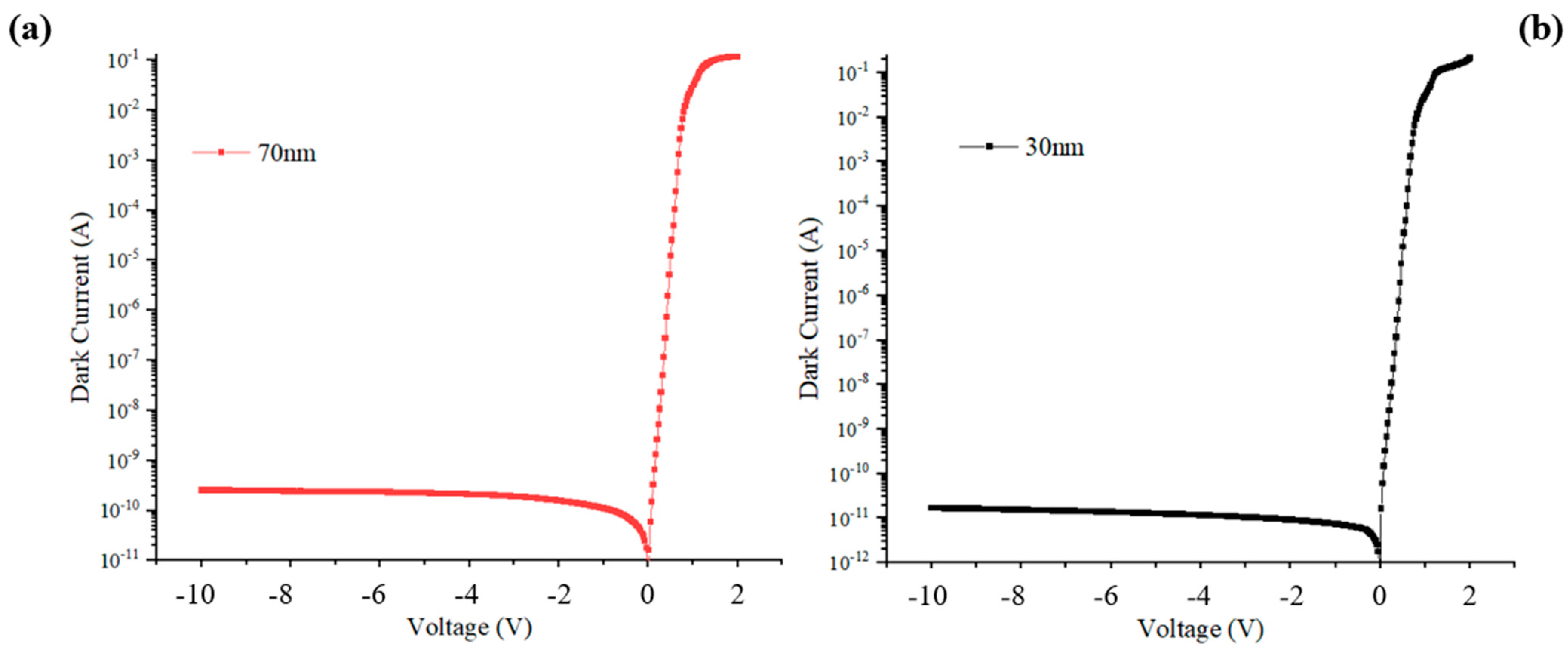
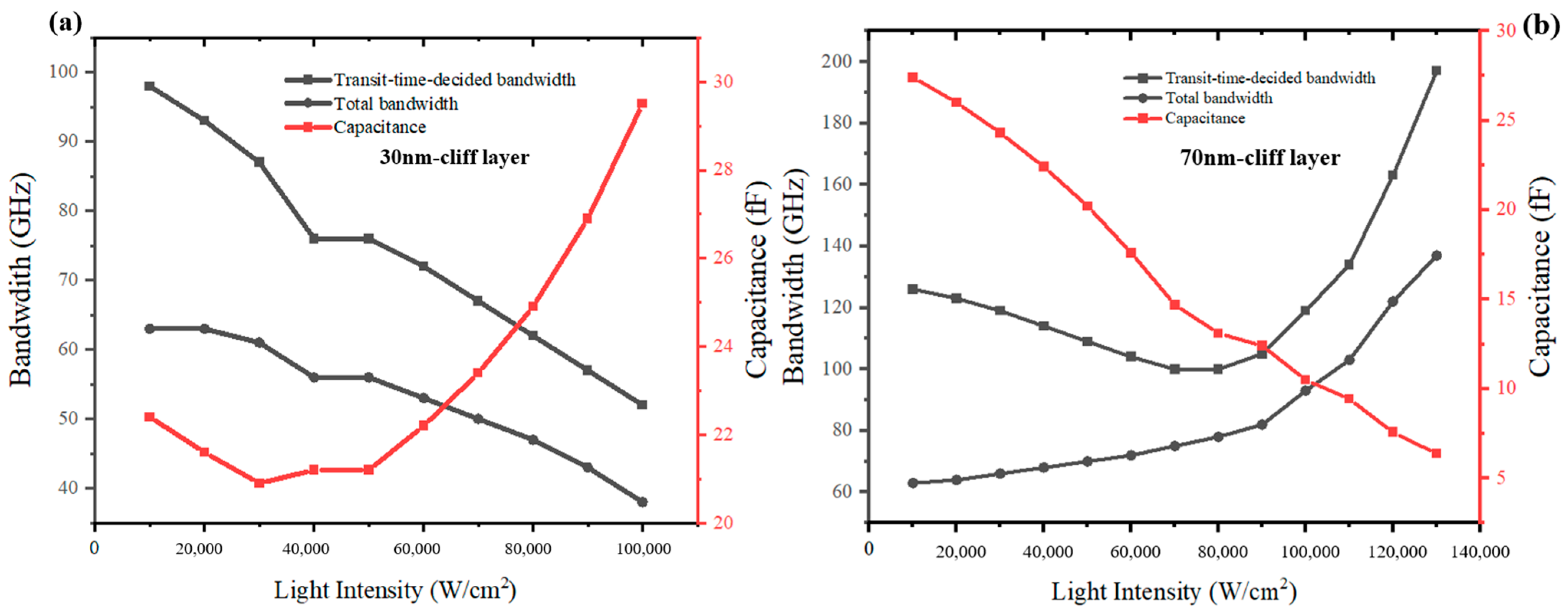


Disclaimer/Publisher’s Note: The statements, opinions and data contained in all publications are solely those of the individual author(s) and contributor(s) and not of MDPI and/or the editor(s). MDPI and/or the editor(s) disclaim responsibility for any injury to people or property resulting from any ideas, methods, instructions or products referred to in the content. |
© 2024 by the authors. Licensee MDPI, Basel, Switzerland. This article is an open access article distributed under the terms and conditions of the Creative Commons Attribution (CC BY) license (https://creativecommons.org/licenses/by/4.0/).
Share and Cite
Dong, X.; Liu, K. Modified Uni-Traveling-Carrier Photodetector with Its Optimized Cliff Layer. Sensors 2024, 24, 2020. https://doi.org/10.3390/s24072020
Dong X, Liu K. Modified Uni-Traveling-Carrier Photodetector with Its Optimized Cliff Layer. Sensors. 2024; 24(7):2020. https://doi.org/10.3390/s24072020
Chicago/Turabian StyleDong, Xiaowen, and Kai Liu. 2024. "Modified Uni-Traveling-Carrier Photodetector with Its Optimized Cliff Layer" Sensors 24, no. 7: 2020. https://doi.org/10.3390/s24072020
APA StyleDong, X., & Liu, K. (2024). Modified Uni-Traveling-Carrier Photodetector with Its Optimized Cliff Layer. Sensors, 24(7), 2020. https://doi.org/10.3390/s24072020






